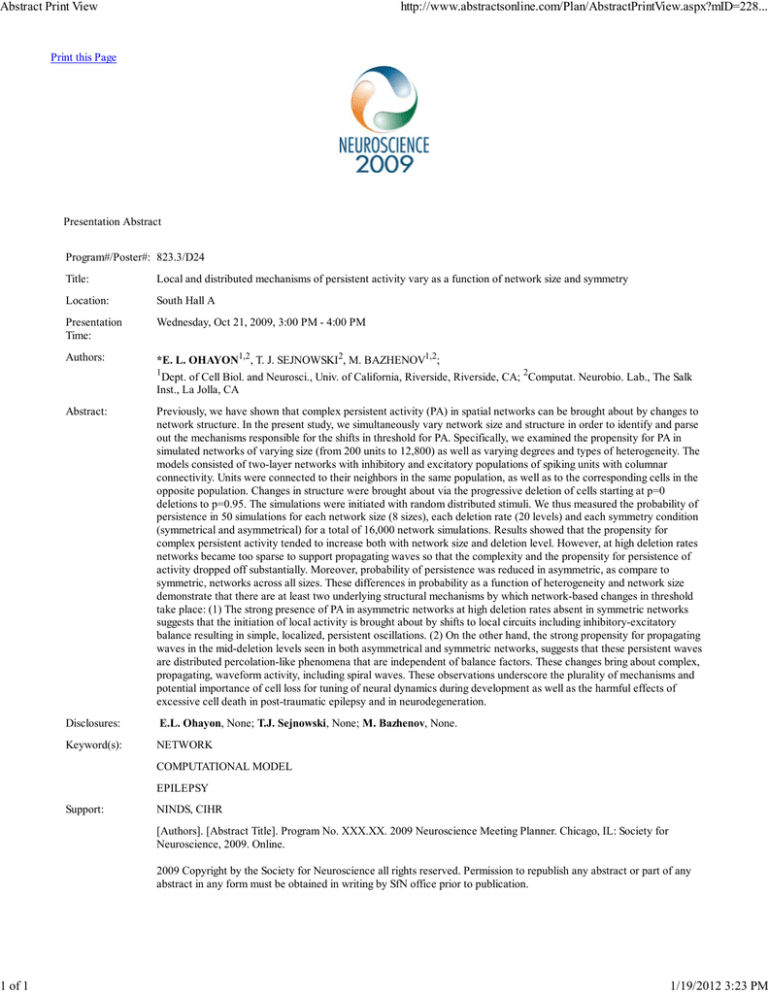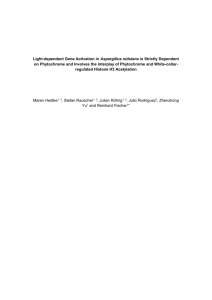
Abstract Print View
1 of 1
http://www.abstractsonline.com/Plan/AbstractPrintView.aspx?mID=228...
Print this Page
Presentation Abstract
Program#/Poster#: 823.3/D24
Title:
Local and distributed mechanisms of persistent activity vary as a function of network size and symmetry
Location:
South Hall A
Presentation
Time:
Wednesday, Oct 21, 2009, 3:00 PM - 4:00 PM
Authors:
*E. L. OHAYON1,2, T. J. SEJNOWSKI2, M. BAZHENOV1,2;
Dept. of Cell Biol. and Neurosci., Univ. of California, Riverside, Riverside, CA; 2Computat. Neurobio. Lab., The Salk
Inst., La Jolla, CA
1
Abstract:
Previously, we have shown that complex persistent activity (PA) in spatial networks can be brought about by changes to
network structure. In the present study, we simultaneously vary network size and structure in order to identify and parse
out the mechanisms responsible for the shifts in threshold for PA. Specifically, we examined the propensity for PA in
simulated networks of varying size (from 200 units to 12,800) as well as varying degrees and types of heterogeneity. The
models consisted of two-layer networks with inhibitory and excitatory populations of spiking units with columnar
connectivity. Units were connected to their neighbors in the same population, as well as to the corresponding cells in the
opposite population. Changes in structure were brought about via the progressive deletion of cells starting at p=0
deletions to p=0.95. The simulations were initiated with random distributed stimuli. We thus measured the probability of
persistence in 50 simulations for each network size (8 sizes), each deletion rate (20 levels) and each symmetry condition
(symmetrical and asymmetrical) for a total of 16,000 network simulations. Results showed that the propensity for
complex persistent activity tended to increase both with network size and deletion level. However, at high deletion rates
networks became too sparse to support propagating waves so that the complexity and the propensity for persistence of
activity dropped off substantially. Moreover, probability of persistence was reduced in asymmetric, as compare to
symmetric, networks across all sizes. These differences in probability as a function of heterogeneity and network size
demonstrate that there are at least two underlying structural mechanisms by which network-based changes in threshold
take place: (1) The strong presence of PA in asymmetric networks at high deletion rates absent in symmetric networks
suggests that the initiation of local activity is brought about by shifts to local circuits including inhibitory-excitatory
balance resulting in simple, localized, persistent oscillations. (2) On the other hand, the strong propensity for propagating
waves in the mid-deletion levels seen in both asymmetrical and symmetric networks, suggests that these persistent waves
are distributed percolation-like phenomena that are independent of balance factors. These changes bring about complex,
propagating, waveform activity, including spiral waves. These observations underscore the plurality of mechanisms and
potential importance of cell loss for tuning of neural dynamics during development as well as the harmful effects of
excessive cell death in post-traumatic epilepsy and in neurodegeneration.
Disclosures:
E.L. Ohayon, None; T.J. Sejnowski, None; M. Bazhenov, None.
Keyword(s):
NETWORK
COMPUTATIONAL MODEL
EPILEPSY
Support:
NINDS, CIHR
[Authors]. [Abstract Title]. Program No. XXX.XX. 2009 Neuroscience Meeting Planner. Chicago, IL: Society for
Neuroscience, 2009. Online.
2009 Copyright by the Society for Neuroscience all rights reserved. Permission to republish any abstract or part of any
abstract in any form must be obtained in writing by SfN office prior to publication.
1/19/2012 3:23 PM








